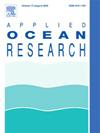海上自升式钻井平台起居舱的非线性分析与重量优化:一种可持续工程方法
IF 4.3
2区 工程技术
Q1 ENGINEERING, OCEAN
引用次数: 0
摘要
自升式钻井平台上的生活区(LQ)在确保极端海上条件下船员安全和操作功能方面起着至关重要的作用。本研究为LQ结构的设计和分析提供了一个全面的结构工程程序,解决了缺乏具体行业标准的问题。该方法集成了关键设备(如直升机甲板和救生艇站)在恶劣环境条件下的全球和局部负载影响。采用有限元分析(FEA)、非线性评价和疲劳评价等多层次分析方法验证结构弹性。该研究成功地验证了LQ结构的极限状态(ULS)、可用性极限状态(SLS)和意外极限状态(ALS)标准。绿水压力下观察到的最大塑性应变为3.8%,远低于15%的允许阈值,具有足够的安全裕度。疲劳分析证实了对涡激振动(VIV)的抵抗,确保了管状构件的耐久性。优化后的LQ结构重量减少了20%,在不影响安全性的情况下提高了效率。拟议的程序弥补了行业标准之间的差距,为设计更安全、更可靠的LQ结构提供了一个强大的框架。该研究通过解决复杂的加载场景和操作挑战,推进了海上工程实践,从而支持能够承受极端海洋条件的弹性自升式钻井平台的开发。本文章由计算机程序翻译,如有差异,请以英文原文为准。
Nonlinear analysis and weight optimization of living quarters for offshore jack-up rigs: A sustainable engineering approach
The living quarters (LQ) on jack-up rigs play a critical role in ensuring crew safety and operational functionality under extreme offshore conditions. This study presents a comprehensive structural engineering procedure for the design and analysis of LQ structures, addressing the absence of specific industry standards. The methodology integrates global and local load effects from critical equipment, such as helidecks and lifeboat stations, under harsh environmental conditions during wet towing. A multi-level analysis approach, including finite element analysis (FEA), nonlinear evaluations, and fatigue assessments, was employed to verify structural resilience. The study successfully validates the LQ structures against ultimate limit state (ULS), serviceability limit state (SLS), and accidental limit state (ALS) criteria. The maximum plastic strain observed under green water pressure was 3.8 %, well below the allowable threshold of 15 %, demonstrating adequate safety margins. Fatigue analysis confirmed resistance to vortex-induced vibrations (VIV), ensuring the durability of tubular members. Optimization efforts reduced LQ structural weight by 20 %, enhancing efficiency without compromising safety. The proposed procedure bridges the gap in industry standards, providing a robust framework for designing safer and more reliable LQ structures. This study advances offshore engineering practices by addressing complex loading scenarios and operational challenges, thereby supporting the development of resilient jack-up rigs capable of enduring extreme marine conditions.
求助全文
通过发布文献求助,成功后即可免费获取论文全文。
去求助
来源期刊

Applied Ocean Research
地学-工程:大洋
CiteScore
8.70
自引率
7.00%
发文量
316
审稿时长
59 days
期刊介绍:
The aim of Applied Ocean Research is to encourage the submission of papers that advance the state of knowledge in a range of topics relevant to ocean engineering.
 求助内容:
求助内容: 应助结果提醒方式:
应助结果提醒方式:


